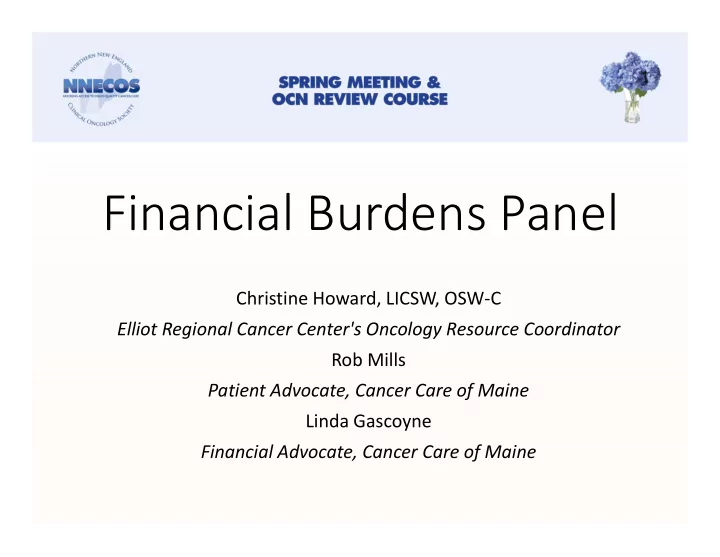

Financial Burdens Panel Christine Howard, LICSW, OSW‐C Elliot Regional Cancer Center's Oncology Resource Coordinator Rob Mills Patient Advocate, Cancer Care of Maine Linda Gascoyne Financial Advocate, Cancer Care of Maine
Did I Consent to That? The Financial Toxicity of Infusion Cancer Therapy
Identify and Educate • A PDF order from the oncologist is electronically distributed to the pharmacist, scheduler, insurance verification and financial navigator. • Discussion with the patient to verify patient has understanding of insurance coverage and financial responsibility. • Follow up after first billing cycle
Degree of Financial Burden • Insurance coverage defined • Patients with commercial insurance plans • Patients with Medicare Advantage plans • Patients with Medicare and Supplement plans • Patients with Medicaid plans • Self Pay patients
How can we do this better? • Standardize the consenting process to include both medical and financial toxicities of a prescribed therapy. • Recognize the financial toxicities are greater than the sum of just the medical bills. • Make the financial a comfortable conversation.
Financial Toxicity of Non‐ elderly Cancer Patients Patients between the ages of 18‐64
Just Imagine • Your doctor diagnoses cancer and says there’s a good chance you can beat it, or keep it under control for a long time. But you can’t afford the thousands of dollars you have to pay for treatment that your health insurer won’t cover. • Many oral cancer medications are well over $20,000.00 per month and quite often, depending on the patient’s health insurance plan carry a high co‐payment that the patient must absorb. That alone is challenging. For the uninsured patient, that dollar figure is impossible.
1.6 Million • In 2016, an estimated 1,685,210 new cases of cancer were diagnosed in the United States and 595,690 people will die from the disease according to a study published by the National Cancer Institute. • The most common cancers in 2016 were breast cancer, lung and bronchus cancer, prostate cancer, colon and rectum cancer, bladder cancer, melanoma of the skin, non‐Hodgkin lymphoma, thyroid cancer, kidney and renal cancer, leukemia, endometrial cancer, and pancreatic cancer.
Nearly One In Three • A new study in the Journal Cancer published February 20 th , 2017 reveals that nearly one in three non‐elderly cancer patients are not taking their prescribed drug regimens because they cannot afford it. • Researchers found, those with cancer are more likely to leave prescriptions unfilled or delay filling prescriptions, skip medication doses to save money, ask doctors to prescribe cheaper drugs, or seek out alternatives to the regimens recommended by their oncologists.
EMMC Cancer Care First Quarter Patient Assistance External Support 10/2016 11/2016 12/2016 01/2017 Rx Co‐Pay Assistance $ 58,360 $ 40,600 $ 132,900 $ 112,000 $343,860 Free Rx $ 1,011,466 $ 152,892 $ 658,030 * $ 829,280 $2,651,668 Replacement Rx $ 33,096 $ 232,945 $ ‐ $ 57,074 $323,115 $ 1,102,922 $ 426,437 $ 790,930 $ 998,354 $3,318,643
• “Remember that every government service, every offer of government ‐ financed security, is paid for in the loss of personal freedom....” ― Ronald Reagan
Examples: State: Federal • For Health Insurance • For Health Insurance • Medicare at age 65 or after • Medicaid‐ $591 collecting disability for 2 years • For Income: • NHHPP (Medicaid • SSDI Expansion)‐ $1,317 • 5 month waiting period • For Income: • Only if disability anticipated to last 1 year • FANF= $539 or result in death • SSI‐ • APTD= $747 • Permanent disability • Brings one “up to poverty”
What does this mean for patients • Few patients who are not impacted financially by a Cancer Diagnosis • Many who suffer a loss in wages • Temporarily unable to work and don’t have benefits • Federal benefits do not kick in • Have difficulty meeting daily expenses such as rent/mortgage and utilities
How does that impact Oncology Social Work? • No Easy Answers • Need to rely on Grass‐roots organizations/grants • Different applications with different requirements • Most require assistance from a social worker
Examples… • Susan G Komen • NH Breast Cancer Coalition • Joe Andruzzi Foundation • Heaps of Hope • Cancer Care
What difference does it make? • Unable to focus on the emotional needs of patients • May lead to dissatisfaction with the Cancer Care system (Hong, S & Cagle, J. (2013). Factors Associated with Perceptions of the Cancer Care System: A Multilevel Modeling Approach. Journal of Psychosocial Oncology, 31(6), 642‐658. )
Maslow’s Hierarchy of Needs
Recommend
More recommend